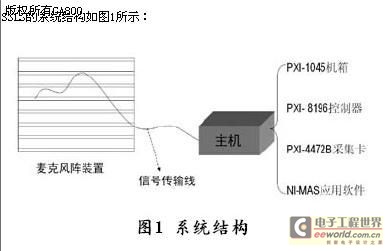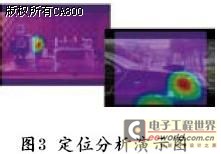2. System Structure The structure of SSLS is shown in Figure 1.

The SSLS designed based on "flexibility test" technology consists of a microphone array device, transmission cable and host computer:
The microphone array device has a unique design (standard array): There are 8 beams, and 8 built-in microphones are placed on each beam. Each beam connects each microphone to the main body bracket through the SMB interface, and a camera placed in the center of the main body bracket is used for real shooting. The entire device features: flexible, compact, lightweight, easy to install - when one of the microphone problems, just replace the corresponding beam, without making other changes; when you need to increase or decrease the microphone, just install or remove the corresponding beam . The entire microphone array device fully reflects the flexibility and expandability of the "flexibility test" technology.

The transmission cable is used to synchronously transmit the electrical signals converted by the array device to the system host. It has the characteristics of uniform length, isolation and shielding between channels.
The host is the core of SSLS. The hardware includes PXI chassis, controllers, and multi-channel dynamic signal acquisition cards. Eight dynamic signal acquisition cards realize the synchronous acquisition of sound signals, especially with anti-aliasing filtering function, with high precision, large dynamic range and other characteristics, designed for dynamic signal acquisition. The PXI chassis backplane bus provides a reliable guarantee for signal acquisition: 1kHz signals are acquired simultaneously across both channels of the board card with a phase difference guaranteed within 0.1 degrees; the controller provides a high-performance platform for real-time test and control applications. SSLS uses the system software developed by the LabVIEW environment. The software can control the system hardware to acquire and analyze the multi-channel sound signals synchronously. The beamforming technology is used to calculate the sound field distribution, and then the sound field distribution map is superimposed on the real-world image to visually reflect the noise. The location of the source. The system software also has the function of array effect simulation. The user can simulate the effects of various microphone arrays configured according to factors such as the environment and signal characteristics, obtain the measuring effect of the matching array, provide the basis for selecting an appropriate formation, and have strong Adaptability and expansion.

The choice of positioning algorithm: Considering the sound field conditions and the diversity of noise equipment, the system uses a beamforming algorithm. In this way, the array device can not only adopt a regular array, but also can use many irregular arrays, such as spiral arrays, random arrays, etc., making the application of positioning more extensive, able to deal with a variety of different conditions;
The choice of hardware and software platforms: Using virtual instrument technology, select the PXI hardware platform. Because the PXI bus has a large data throughput capability, it can meet the needs of synchronous acquisition of multi-channel dynamic data, and at the same time it is convenient to add or delete channels later, making the system have good scalability and flexibility;
Software technology: Considering that various array devices can be conveniently and quickly replaced when used, the modular design concept is adopted when designing the system software. When using different array devices, the operator only needs to import the corresponding array configuration file.
The design of the system also incorporates other design techniques, such as the design of the array device, and the use of modular interface technology, making the expansion, assembly, and disassembly of the array device both convenient and quick.
4, system function SSLS can make the sound "visualization", can help the acoustic engineer "see" the sound field distribution of the noise object under test, find out the position of each main sound source point, it is the sharp weapon that extracts the useful information from the complicated sound signal. Its functions include:
Sound source localization: Shows the relative energy of the sound field at various locations within the analysis plane. According to the energy distribution map, the location of each major sound source can be found.
Identifying different sound sources: Displays the distribution of the sound field in a specified frequency band, thus identifying the main sound sources in different frequency bands in a noisy sound environment;
Separation and analysis of sound source signals: The sound source signal of a specified position is separated from a complex sound signal, and then the sound source signal is subjected to sound playback and spectrum analysis, and the user can also perform custom analysis on the separated signal.
Spectrum analysis: According to user settings, spectrum analysis can be performed on acoustic signals for a specific time period;
Joint time-frequency analysis: display the energy spectrum information of sound signals with time and frequency as axes.
5, system characteristics SSLS fully integrates the "flexibility test" technology and sound processing technology, has the following characteristics:
Multi-source positioning: Within the allowed resolution range, the system can locate multiple sound sources simultaneously.
Convenient array placement: The system is different from the general near-field acoustic holography method. It does not need to put the microphone array close to the surface of the measured object (d<<λ), which increases the “vision†of the system and avoids the near-field sound. The holographic method has limitations on the position of the array.
Flexible array configuration: The system's array can be flexibly configured according to different sound field conditions, so as to obtain ideal analysis results, so the system can be applied to a variety of different sound field conditions.
Intuitive display mode: The system displays the sound field energy distribution on the measured object picture. By observing the picture, you can intuitively see the location of the sound source on the measured object.
6. Summary "Flexible test" technology is emerging test technology under complex and changing market pressures. The biggest advantage of this technology is that it can meet the complex and varied test and measurement requirements of different manufacturing industries. "Flexible test" technology integrates virtual instruments, test and measurement, mechatronics, network communications and software, and is a refinement of the multi-year technology precipitation in the test and measurement industry. SSLS is adhering to the concept of “flexibility testing†and considers meeting customer needs in a timely and effective manner as the ultimate pursuit. It fully considers factors such as variability, complexity, and cost feasibility, and has strong flexibility, adaptability, and expansion. Sex, can meet the needs of customers for a variety of sound field conditions analysis, easy installation, easy maintenance, fully comply with the development direction of modern test systems, is the perfect embodiment of "flexibility testing" technology.
1. The three in one central non-woven fabric is made of inorganic antibacterial materials, which can play an antibacterial and Deodorizing role.
2. High quality polypropylene non-woven fabric, three-layer thickening protection design.The inner layer is composed of comfortable, soft and non irritant fabric, which can avoid itching and scratching.
3. Made of low sensitive materials, soft, comfortable and non irritating.Special design: soft elastic ear hook, not easy to fall off, can reduce the hand touch mask, elastic ear hook design can reduce the pressure on the ear
4. Ultrasonic seamless edge pressing can cover the nose, mouth and chin perfectly, providing comprehensive protection. Our masks provide a guarantee for your health and safety at work and when you go out.
Color: Blue
Package quantity: 50 disposable non-woven masks
Surgical mask,Medical mask,Best face mask,disposable face mask
Guangdong Giant Fluorine Energy Saving Technology Co.,Ltd , https://www.tuwtechs.com